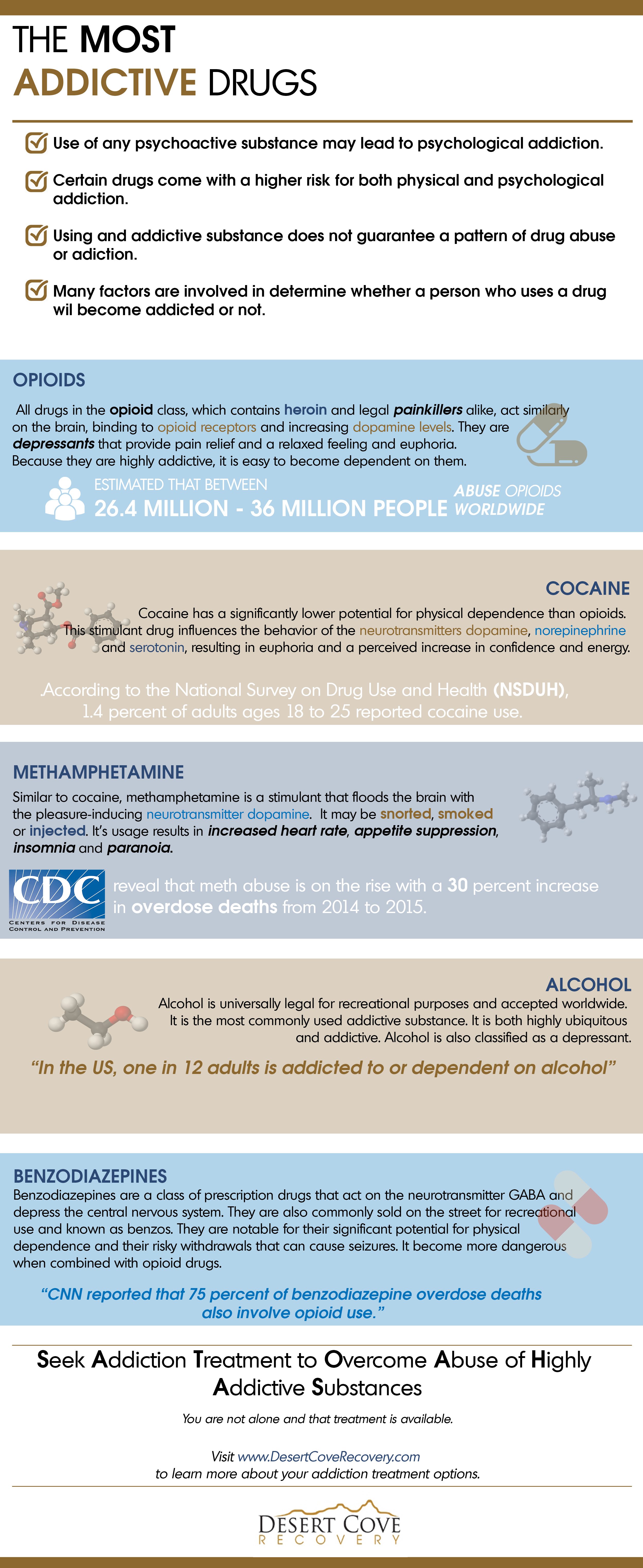What Are the 5 Most Addictive Substances?
While use of any psychoactive substance with pleasurable effects may lead to psychological addiction, certain drugs come with a heightened potential for both physical and psychological addiction. Physical dependence compounds the psychological aspects of addiction as both body and mind crave the drug, resulting in difficult withdrawals. Drugs with these properties have earned notoriety as the most addictive substances in the world.
Using an addictive substance does not guarantee that a pattern of drug abuse will follow. Whether a person becomes addicted to a substance depends on complex factors such as genetics. Repeated use of a highly addictive drug will put the user at a higher risk of developing a habit that requires treatment, particularly if the user is turning to the substance as a coping mechanism.
A scale developed by drug researcher David Nutt and his colleagues is commonly referenced in lists that rank the most addictive substances. The published report assesses how dangerous each drug is based on its potential for dependence, physical harm and social harm on a scale of zero to three. The dependence score takes into account pleasure, physical dependence and psychological dependence.
(Continued below image…)
So, what are the most addictive drugs? Here are five that are high on the list:
Opioids
Heroin, an opioid, earned the highest mean score on Nutt’s dependence ranking with a 3.00. It also ranked as the most dangerous drug overall once physical and social harm were taken into account. All drugs in the opioid class, which contains heroin and legal painkillers alike, act similarly on the brain, binding to opioid receptors and increasing dopamine levels. Opioids are depressants that provide pain relief and a feeling of relaxation and euphoria. Because opioids are highly addictive, it’s not uncommon for those who are prescribed painkillers to become dependent and start seeking out heroin on the street. Between 26.4 million and 36 million people are estimated to abuse opioids worldwide.
Cocaine
Cocaine has a significantly lower potential for physical dependence than opioids, but it comes second to heroin on Nutt’s dependence scale with a 2.39 because its ratings for psychological dependence and pleasure are high. Both crack and powder cocaine are included in the rating. This stimulant drug influences the behavior of the neurotransmitters dopamine, norepinephrine and serotonin, resulting in euphoria and a perceived increase in confidence and energy. According to the National Survey on Drug Use and Health (NSDUH), young adults have the highest rate of cocaine use. In the survey, 1.4 percent of adults ages 18 to 25 reported cocaine use within the past month.
Methamphetamine
Similar to cocaine, methamphetamine is a stimulant that floods the brain with the pleasure-inducing neurotransmitter dopamine. Known as crystal meth on the street, this drug may be snorted, smoked or injected. Meth use results in increased heart rate, appetite suppression, insomnia and paranoia. Statistics from the Centers for Disease Control and Prevention (CDC) reveal that methamphetamine abuse is on the rise with a 30 percent increase in overdose deaths from 2014 to 2015.
Alcohol
Unlike many other drugs, alcohol is universally legal for recreational purposes and is widely accepted by the mainstream. It is frequently cited as the most commonly used addictive substance. Because alcohol is both highly ubiquitous and addictive, a vulnerable person can easily become exposed to it and then addicted. In the US, one in 12 adults is addicted to or dependent on alcohol, which gets an overall addictiveness score of 1.93 according to Nutt’s rating system. Alcohol is classified as a depressant, but its initial effects are more like those caused by a stimulant. Users typically become more talkative and outgoing prior to experiencing alcohol’s sedating effects.
Benzodiazepines
Benzodiazepines are a class of prescription drugs that act on the neurotransmitter GABA and depress the central nervous system. Due to their sedating properties, they are frequently prescribed for anxiety and insomnia, but unfortunately, some patients end up abusing them. Benzodiazepines are also commonly sold on the street for recreational use and known as benzos. They have a mean dependence score of 1.83 on Nutt’s scale. They are notable for their significant potential for physical dependence and their risky withdrawals that can cause seizures. Benzodiazepines become more dangerous when combined with opioid drugs, and a study reported on by CNN found that 75 percent of benzodiazepine overdose deaths also involve opioid use.
Seek Addiction Treatment to Overcome Abuse of Highly Addictive Substances
Drug abuse is a serious problem all over the world as people from all walks of life turn to psychoactive substances to cope with their struggles, and the more addictive a substance is, the greater the risk.
If you or a loved one is battling addiction, know that you are not alone and that treatment is available. Placeholder is a drug rehabilitation center that provides treatment for addiction to the substances mentioned in this list. Contact an addiction counselor today to learn more about your addiction treatment options.
Sources:
http://www.sciencedirect.com/science/article/pii/S0140673607604644
https://www.drugabuse.gov/about-nida/legislative-activities/testimony-to-congress/2016/americas-addiction-to-opioids-heroin-prescription-drug-abuse
https://www.drugabuse.gov/publications/research-reports/cocaine/what-scope-cocaine-use-in-united-states
https://www.cdc.gov/nchs/data/databriefs/db273.pdf
https://www.ncadd.org/about-addiction/alcohol/facts-about-alcohol
http://www.cnn.com/2016/02/18/health/benzodiazepine-sedative-overdose-death-increase/index.html




